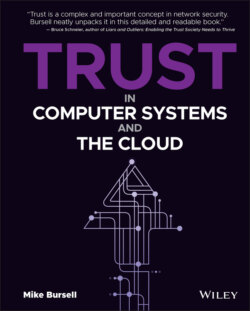Читать книгу Trust in Computer Systems and the Cloud - Mike Bursell - Страница 26
Theories of Institutional Trust
ОглавлениеOne of the most famous and influential early modern writers on the topic of institutional trust in the West, at least, was Thomas Hobbes,16 in his Leviathan, originally published in 1651. In fact, the full title of his book was Leviathan: Or the Matter, Forme and Power of a Commonwealth, Ecclesiasticall and Civil, and it is considered an important early work in social contract theory. This theory—the name is taken from another giant in the field, Jean-Jacques Rousseau's The Social Contract17—suggests that we—members of societies—give up some rights that we might otherwise exercise and give them, instead, to institutions.
Hobbes's central thesis is that people (he would say “men”) are, by default, in “a state of nature” in which they are “brutish and at warre” with one another. In other words, without some sort of authority structures, there can be no society beyond simple interpersonal relationships. To overcome this restriction, humans create agreements to give up some of their rights to take from each other—though never to defend themselves—by imbuing rights into a sovereign body. This sovereign body is preferably, in Hobbes's view, a monarch and has the power to create laws and exact punishment. Though the work is a masterpiece and still worth reading, certain issues stand out to a more modern reader, including, crucially, how such sovereign bodies are ordained18 and sustained if there is no continual re-establishment of the sovereignty by its body politic.
If we ignore Hobbes's preference for a monarch as the structural centre and overlook for now the question of how exactly a central authority is established (a topic to which we will return in Chapter 3, “Trust Operations and Alternatives”) we may consider the possibility that trust in this central authority could be continually re-established, but we must remember that such trust is really made up of many separate trust relationships to the authority. There is a distinction here between the set of trust relationships held and the reputation of the authority: the latter, while theoretically a reflection of all the former, is not a true view of it in the context of two important measures:
The conglomeration of information about trust relationships will always be imperfect in practice, in the same way that a map is never a true representation of a tract of land (a perfect representation becomes more than a representation and becomes part of what it is representing19).
Reputation is information allowing an entity to consider the formation—or tuning—of a trust relationship rather than the relationship itself.
This is a distinction that often seems to be lost in discussions of institutional trust—or, more specifically, trust relationships to institutions. Either little difference is evinced between reputation and trust, or the fact that different parties hold different relationships is overlooked. One notable exception to this is Francis Fukuyama, whose 1995 book Trust: The Social Virtues and the Creation of Prosperity20 is one of the canonical works in the modern discussion of institutional trust. In it, he examines the role of social capital, familism, individualism, and sociability in economic growth, in particular their effects on how corporations and companies form. He argues strongly that mutual trust, a commodity linked to the concept of social capital,21 is very important to how people in different cultures form groups and corporations.
Another approach is that taken by Onora O'Neill,22 who takes as one of her starting points that “trust is social”, and then goes on to discuss the “crisis of trust” in public institutions, another example of mistrust being taken as a core aspect to be studied. O'Neill then goes on to consider how this can be managed, suggesting that transparency (a removal of secrecy) is not enough if we cannot remove deception and that true accountability involves the ability to make informed, deliberate (and individually autonomous) choices. Although the language here may seem somewhat different to what we have been using, the accent on choices that are both informed and individual is very consonant with our approach.
A final example in this area is a work by Diego Gambetta, whose 1988 essay “Mafia: the Price of Mistrust”23 both explicitly deals with mistrust and also discusses very different alternatives to institutions as instantiations of Hobbes's structural authorities as the centre for trust networks. He suggests that the Mafia in Sicily and southern Italy is successful for a variety of reasons: through fear of sanctions; because cooperation with the Mafia enhances people's mutual economic interests; because people have general reasons (cultural, moral, or religious) for believing that cooperation is good irrespective of sanctions and rewards; and because people are related by bonds of kin or friendship. It is worth considering, as in the case of the Prisoner's Dilemma, whether the sort of trust relationship that an individual might have to the Mafia might actually meet our definition of trust, remembering that the assurance of bad behaviour meets it equally as well as assurance of good behaviour.
We might also consider the differences between informal institutions like the Mafia and formal institutions like a monarchy. Author Henry Farrell24 makes an interesting distinction between trust/distrust in informal institutions as opposed to formal institutions such as those we have been examining so far. To state it in the terms we have been using, the distinction is that the context(s) of the trust relationship that a person holds to the Mafia are very far being well-defined: in this case, they are very ill-defined. This means a “certain fuzziness” in how to behave in certain situations dominates the relationship, as the institution itself is informal.
